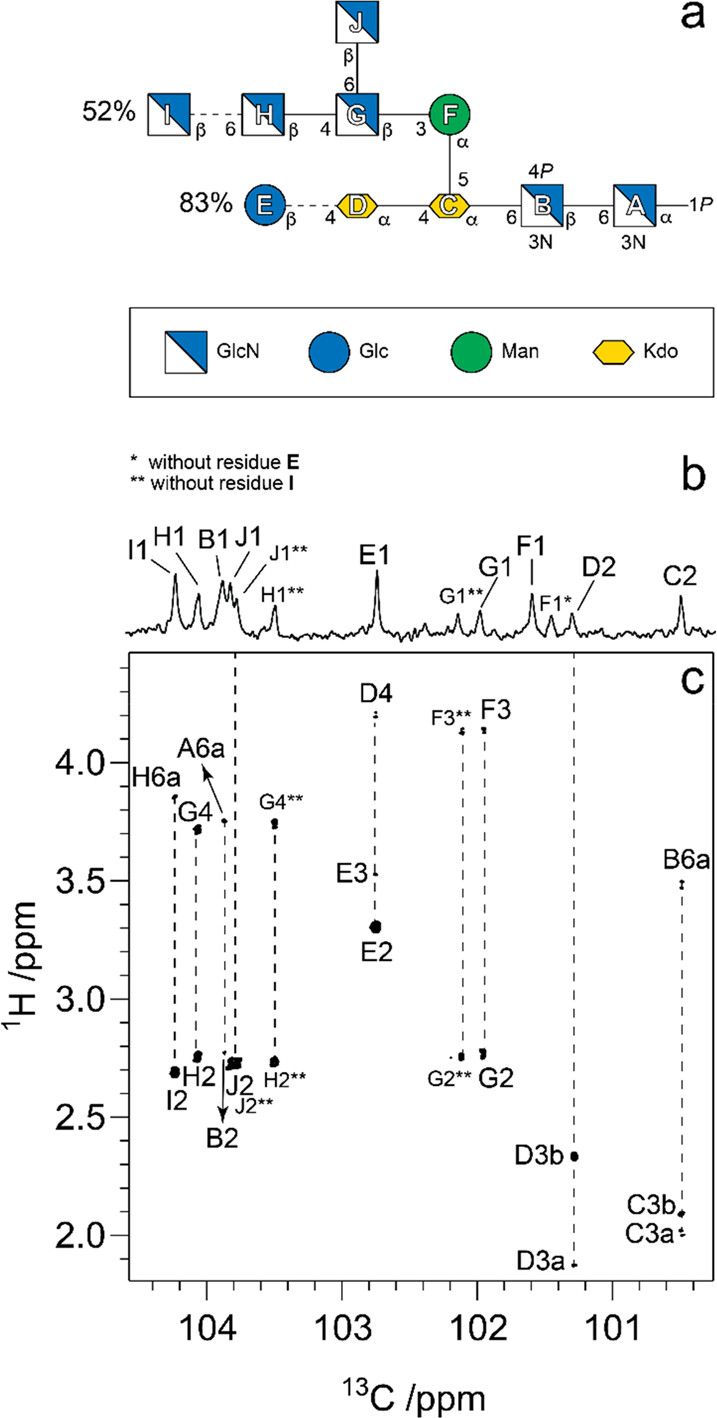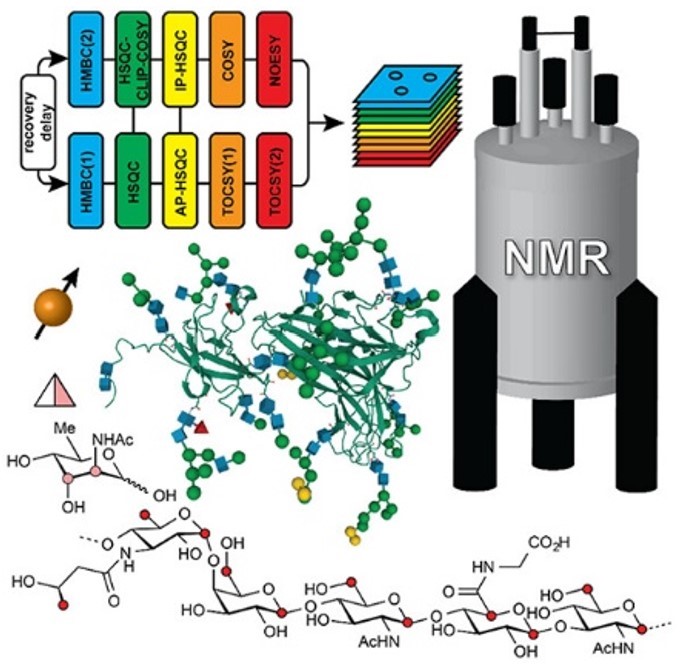Nuclear Magnetic Resonance (NMR) Spectroscopy for Glycan Analysis
Glycan analysis is very challenging because of the extremely high number of possible isomers that can be formed by naturally occurring monosaccharides. Over the last years, the analysis of glycoproteins and complex glycans has made great progress mainly because of the improvement of analytical instruments, such as nuclear magnetic resonance (NMR) spectroscopy. With years of experience in the condition optimization of NMR spectroscopy for glycan analysis, Creative Biolabs has gained significant knowledge to offer high-quality service. We are happy to share our knowledge and passion in this field to facilitate our customers’ research and project development.
Application of NMR Spectroscopy for Glycan Analysis
Glycans, most often in the form of glycoconjugates such as N- or O-linked glycoproteins, proteoglycans, and polysaccharides, are an important class of biomolecules that are involved in molecular recognition, protein trafficking, regulation, and inflammation among other things. The rapid evolution in glycomics area has indicated that the structure of glycans from glycoproteins is highly relevant for their function. To comprehensively understand the function of glycoproteins, the glycan structures must be determined as accurately as possible.
Many methods for glycan analysis have been developed depending on the analytical methods used, data on the composition, sequence, linkage, branching, and anomericity. For instance, mass spectrometry (MS)-based methods can be used to carry out for glycan profiling rapidly, but it relies on knowledge of conserved structures and to some extent on known biosynthetic pathways. NMR spectroscopy of glycans leads to breakthrough in the glycan analysis. NMR spectroscopy can determine stereochemical relationships of completely novel sugars and in a reliable way also the anomeric configuration. However, limited sensitivity in high molecular mass systems is the main disadvantage in the application of NMR spectroscopy. The recent improvements in sensitivity include cryo-probe technology, “single-scan 2D techniques”, and dynamic nuclear polarization, promising efficient application of NMR spectroscopy for carbohydrate analysis. Solution NMR spectroscopy is an ideal technique to characterize the structure and dynamics of conformationally labile systems. Polysaccharides themselves are conformationally labile due to a lack of short- or long-range stabilizing interactions, but all members of a conformationally labile moiety often contribute to observable NMR parameters. Given the intrinsic dynamic nature of glycans, NMR spectroscopy can afford exquisite structural information at the atomic detail, not accessible by other techniques.
 Fig.1 NMR-based analysis of glycans.1
Fig.1 NMR-based analysis of glycans.1
NMR Spectroscopy for Glycan Analysis Service at Creative Biolabs
To unravel the biological roles of glycans, many approaches have been developed. Among them, NMR spectroscopy is a very powerful tool for the analysis of glycoprotein and complex glycans. Our professional technical scientists are proficient in applying NMR spectroscopy to determine the primary and tertiary structure of glycans from glycoprotein and polysaccharides. The sensitivity has been highly improved by the optimization of buffer suppression and sample preparation. Moreover, this technique is nondestructive, leaving the sample intact for further analysis.
Highlights
-
Nondestructive, leaving the sample intact for further analysis
-
Small sample amounts
-
Highly sensitive
-
Highly professional Ph.D. level scientists
-
Tailored research & services
Glycobiology turned to be a fertile field for NMR spectroscopy. Powered by our world-leading technology platforms and experienced technical personnel, Creative Biolabs is fully competent and dedicated to serving as your one-stop-shop for glycan analysis by NMR spectroscopy. If you are interested in NMR spectroscopy for glycan analysis, please don’t hesitate to contact us for more detailed information.
Published data
Glycans are important carbohydrate molecules with diverse structures that are involved in several physiological processes. NMR is a reliable tool used to determine the primary structure of glycans, including elucidation of the heterojunction, bonding, absolute and cyclic configurations, substituents, and sequences of the glycan components. This technique has been developed to improve its sensitivity and resonance resolution. Understanding the different sugar residues in glycans with the help of NMR can not only provide valuable information for glycan structure and biosynthesis studies but also lay the foundation for understanding how glycans interact with other molecules.
 Fig.2 NMR is an effective tool for primary structure analysis of glycans.1
Fig.2 NMR is an effective tool for primary structure analysis of glycans.1
FAQs
Q1: What is the significance of NMR-based glycan analysis in disease research?
A1: NMR provides fine structural information for glycan analysis from atomic details. The analysis of glycan structure helps to understand the role of glycans in pathological processes and lays the foundation for screening biomarkers for diseases such as cancer.
Q2: What results are delivered at the end of the experiment?
A2: After NMR analysis, we provide original NMR profiles and detailed glycan analysis results. Besides, we also provide after-sales service to answer any questions you may have.
Customer Review
Attention to Detail in NMR Analysis
"Creative Biolabs was excellent at both NMR analysis and data analysis. From the development of the protocol to the delivery of the final analysis report, the whole process was very efficient and smooth. We were also impressed with their attention to every detail of the assay. Thanks for their help in our glycan study."
Detailed NMR Analysis
"Creative Biolabs was very good at using NMR to analyze glycan structures. They provided detailed analysis reports and insights based on the assay results, information that was crucial to our research project. We were also very satisfied with the communication and efficiency of the whole process. They were recommended for this NMR analysis service."
Reference
-
Fontana, Carolina, and Goran Widmalm. "Primary structure of glycans by NMR spectroscopy." Chemical Reviews 123.3 (2023): 1040-1102. Distributed under Open Access license CC BY 4.0, without modification.
For Research Use Only.
Related Services

 Fig.1 NMR-based analysis of glycans.1
Fig.1 NMR-based analysis of glycans.1
 Fig.2 NMR is an effective tool for primary structure analysis of glycans.1
Fig.2 NMR is an effective tool for primary structure analysis of glycans.1



